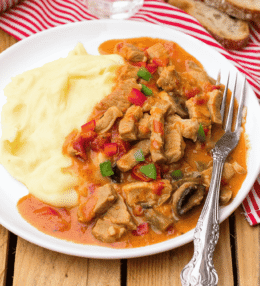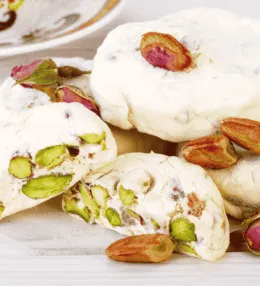
- View
Table of Contents
ToggleKvass is the kind of drink that quietly tells the story of a people. Made from fermented rye bread, it is earthy, slightly sweet, lightly tangy, and often just a touch fizzy. In Russia, it is more than refreshment. It is part of the rhythm of daily life.
Often described as a bread soda or rustic beer without the alcohol, Kvass is both nourishing and nostalgic. It quenches thirst in summer heat, pairs well with hearty dishes, and carries a deep, familiar taste that lingers kindly.
Though bottled versions are now found in supermarkets, traditional Kvass remains a point of pride in many Russian homes. It is a drink born from simplicity, yet rich with cultural weight and everyday presence.
Want to dive deeper into Russian Cuisine? Don’t miss our post on 30 Traditional Russian Foods to Try
What Is Kvass?
Kvass is a naturally fermented beverage made by soaking dark rye bread in water, then allowing it to ferment with yeast and sugar. The result is a mildly tangy, refreshing drink with low alcohol content, usually less than one percent.
It is often served chilled, poured into glasses with a foamy head similar to that of beer. Sometimes raisins or herbs like mint are added for extra depth. In many households, it is poured from reused plastic bottles or kept cool in large glass jars.
Despite its simplicity, Kvass has many forms. Some versions lean sour, others sweeter. Some are carbonated naturally, others slightly still. But all share the grainy, grounded flavour of rye bread softened by fermentation.
Ingredients and Taste
The base of Kvass is stale rye bread, toasted for depth, then soaked in boiling water. Once cooled, yeast and sugar are added to start the fermentation. Some recipes include raisins, lemon peel, or herbs to lift the flavour.
After a few days, the mix becomes lightly fizzy, earthy, and slightly sour. The taste is unmistakably bready but not heavy. It feels light on the tongue, with subtle sweetness and a gentle tang that dances without overpowering.
Kvass is not designed to shock the palate. Instead, it rewards slower sipping. The flavour builds with each mouthful, delivering refreshment with a hint of something older, something enduring. It is rustic, yet clean in its finish.
A Taste of History
Kvass dates back over a thousand years, woven into the early fabric of Slavic life. Long before tea or coffee reached Russian tables, Kvass was the daily drink. It was safer than water, easy to make, and sustained workers and families alike.
It was sold from wooden barrels on street corners, offered in clay cups, or brewed at home using leftover bread. It crossed class lines and seasons. In cities and villages, Kvass connected people through something familiar and nourishing.
During the Soviet era, Kvass became even more entrenched in daily life. Children drank it alongside meals. Workers lined up at yellow street carts. It was part of the everyday without ever feeling ordinary.
Today, Kvass holds a special place between tradition and routine. It continues to adapt, appearing in cans and bottles, yet its core remains. It is a drink that tastes like memory, rooted in grain, time, and care and still loved across generations.
How to make Kvass
Kvass is a traditional Russian fermented beverage made from dark rye bread, yeast, and sugar. Slightly tangy, mildly sweet, and gently fizzy, Kvass offers a natural refreshment with a malty depth. It requires time to ferment, but the result is a drink that carries centuries of Slavic tradition in every sip. See the recipe card at the bottom for printable directions
Ingredients
For the bread base
- 300g dark rye bread (preferably stale or dried)
- 2 litres filtered water
For the fermentation
- 100g granulated sugar
- 10g active dry yeast (or 20g fresh yeast)
- 1 tbsp raisins (optional, for natural carbonation)
Optional flavouring
- 1 tbsp fresh mint leaves or lemon peel (for aroma)
Cooking Instructions
Step 1: Toast the bread
To begin, preheat your oven to 180°C. Slice the rye bread into small cubes and spread them on a baking tray. Toast for 20 to 30 minutes until deep brown but not burnt. This intensifies the malty flavour. Proceed to soaking the bread.
Step 2: Make the bread infusion
Place the toasted bread into a large non-metallic bowl or pot. Pour over 2 litres of boiling filtered water. Cover and let steep for 4 to 6 hours at room temperature until cooled and richly infused. Move to straining the mixture.
Step 3: Strain the liquid
Strain the bread infusion through a fine sieve or muslin cloth into a clean glass or enamel container. Discard the bread solids. This liquid forms the base of your Kvass. Transition to adding fermenting agents.
Step 4: Add yeast and sugar
Dissolve the sugar in the warm bread liquid (not above 38°C). Add the active dry yeast and stir gently. If using lemon peel or mint, add them now for aroma. Cover loosely and let it stand for 12 to 16 hours in a warm place. Continue to bottling.
Step 5: Bottle the Kvass
Once fermented, skim off any foam. Pour the Kvass into clean bottles, leaving a little space at the top. Add a couple of raisins to each bottle if desired. Seal tightly. Proceed to second fermentation.
Step 6: Carbonate the drink
Leave the bottled Kvass at room temperature for 1 to 2 days to develop natural carbonation. The raisins will float when the Kvass is fizzy enough. Transfer to the refrigerator after. Transition to cooling completely.
Step 7: Chill before serving
Chill the Kvass in the fridge for at least 12 hours before serving. This halts fermentation and balances the flavour. Prepare your glasses and optional garnish.
Final Step: Serve cold
Pour the Kvass into glasses, optionally straining out the raisins. Serve cold with a slice of lemon or a sprig of mint. It pairs well with hearty Russian dishes or can be enjoyed as a light refreshment on its own.
Variations and substitutions
- Use sourdough rye bread for a tangier profile.
- Replace sugar with honey or molasses for deeper sweetness.
- Add grated beetroot during infusion for a subtle earthy tone and pink hue.
Cooking Tips for Perfect Kvass
- Use filtered or boiled water to avoid unwanted bacteria.
- Do not exceed 38°C when adding yeast or you may kill it.
- Taste during second fermentation to avoid over carbonation.
- Store in the fridge once fizzy to maintain ideal flavour and prevent exploding bottles.
- Use glass swing top bottles for best fermentation and pressure control.

Russian Kvass (Fermented Rye Bread Drink)
Ingredients
For the bread base
- 300 g dark rye bread preferably stale or dried
- 2 litres filtered water
For the fermentation
- 100 g granulated sugar
- 10 g active dry yeast or 20g fresh yeast
- 1 tbsp raisins optional, for natural carbonation
Optional flavouring
- 1 tbsp fresh mint leaves or lemon peel for aroma
Instructions
- To begin, preheat your oven to 180°C. Slice the rye bread into small cubes and spread them on a baking tray. Toast for 20 to 30 minutes until deep brown but not burnt. This intensifies the malty flavour. Proceed to soaking the bread.
- Place the toasted bread into a large non-metallic bowl or pot. Pour over 2 litres of boiling filtered water. Cover and let steep for 4 to 6 hours at room temperature until cooled and richly infused. Move to straining the mixture.
- Strain the bread infusion through a fine sieve or muslin cloth into a clean glass or enamel container. Discard the bread solids. This liquid forms the base of your Kvass. Transition to adding fermenting agents.
- Dissolve the sugar in the warm bread liquid (not above 38°C). Add the active dry yeast and stir gently. If using lemon peel or mint, add them now for aroma. Cover loosely and let it stand for 12 to 16 hours in a warm place. Continue to bottling.
- Once fermented, skim off any foam. Pour the Kvass into clean bottles, leaving a little space at the top. Add a couple of raisins to each bottle if desired. Seal tightly. Proceed to second fermentation.
- Leave the bottled Kvass at room temperature for 1 to 2 days to develop natural carbonation. The raisins will float when the Kvass is fizzy enough. Transfer to the refrigerator after. Transition to cooling completely.
- Chill the Kvass in the fridge for at least 12 hours before serving. This halts fermentation and balances the flavour. Prepare your glasses and optional garnish.
- Pour the Kvass into glasses, optionally straining out the raisins. Serve cold with a slice of lemon or a sprig of mint. It pairs well with hearty Russian dishes or can be enjoyed as a light refreshment on its own.
Nutrition
You May Also Like







Leave a Review